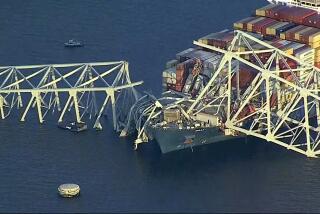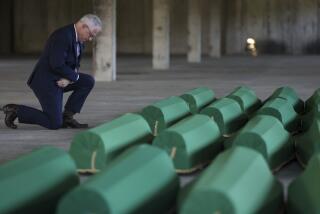Postscript : A Bridge of Disunity : Now in Bosnian Serb hands, the ancient Drina River span crosses an age-old flash point between Christians and Muslims.
- Share via
VISEGRAD, Bosnia-Herzegovina — Amid the destruction inflicted on eastern Bosnia by nationalist Serbs, a 16th-Century bridge of cream-colored stone bears witness to the region’s Ottoman past and a legacy of resentment that haunts the present and the future of this ruined land.
For Bosnian Serbs, the bridge’s 11 arches spanning the River Drina represent the linking of Serb lands. For Muslims, they symbolize the connection of Bosnia’s diverse peoples and cultures.
And for the outside world, the graceful span that has been repeatedly attacked, destroyed and rebuilt in its rich, 400-year history epitomizes the tragic endurance of the southern Slavs who straddle one of this millennium’s greatest political divides.
The Drina valley formed the boundary between the Christian Hapsburg and Muslim Ottoman empires at the start of this century. More importantly, during the previous 500 years, when Turks occupied both banks, it proved the divide between the Christian Orthodox of Serbia who defiantly resisted conversion to Islam, and those in Bosnia who succumbed, becoming the forebears of today’s Slavic Muslims.
It was in the Drina valley that Serb forces undertook some of their most brutal operations at the start of the current war, which has taken 200,000 lives, most of them Muslims’. Here, Serb nationalists embarked on a drive to grab territory for a Greater Serbia, inaugurating their infamous practice of “ethnic cleansing.”
Muslims, who make up the majority population in the Drina valley that forms much of Bosnia’s eastern frontier, were expelled and murdered even before the rebellion reached the Bosnian capital of Sarajevo and riveted international attention on the bloodiest of successive conflicts spurred by the breakup of Yugoslavia.
A heavy silence now hangs over Visegrad. Two-thirds of its prewar population of 21,000 is gone, and fighting-age men from the Serb remnant are mostly deployed to more active fronts.
On a road slicing through the dense, hilly woodlands of eastern Bosnia, the landscape is tainted by a chain of deserted villages and burned-out houses. In one hamlet on the way to Visegrad, a trace of Muslim heritage remains--a smashed minaret on a heap of rubble.
Under an international peace plan, overwhelmingly rejected by the Bosnian Serbs, the bridge and this town that stands less than 10 miles from the Serbian border are designated to be restored to the rule of the Muslim-led Bosnian government.
The Serbs of Visegrad cherish the bridge despite the fact it was built by an Ottoman grand vizier, Mehmed Pasha Sokolovic, who ruled Bosnia from 1565 to 1579. After all, explains Snezana Kojic, a Visegrad councilwoman, Mehmed Pasha was originally an Orthodox Serb who as a child was kidnaped by the Turks from his home near the Drina.
Her account largely coincides with that told in “The Bridge on the Drina,” the novel in which the late Ivo Andric, a Yugoslav diplomat and writer, wove the story of the bridge into four centuries of Bosnian history. Andric said the bridge “formed an indispensable link on the road between Bosnia and Serbia.” This and further works won him the Nobel Prize for Literature in 1961.
Turkish script etched in stone remains in the middle of the oft-repaired 180-yard structure, recounting for travelers Mehmed Pasha’s role in its construction.
Asked why this Ottoman treasure escaped the devastation inflicted on most Muslim monuments, Councilwoman Kojic answers, “It connects Serbs on both banks of the Drina.”
“In any case,” she adds, “Mehmed Pasha went back to his Serbian roots when he came here to build the bridge.”
The vizier built the bridge over “steep banks and the evil water between them, joining the two ends of the road which was broken by the Drina and thus link safely and forever Bosnia and the East, the place of his origin and the places of his life,” wrote Andric.
The legend describes how Mehmed Pasha struggled against evil witches who undid the work each night until he buried two Serb children in the bridge as a lesson to the saboteurs.
Today, local Serbs say they will never give up Visegrad or other lands they consider to have been “stolen” when Bosnian Serbs converted to Islam centuries ago. The lands have been reclaimed through the spilling of Serb blood and, as the rebels see it, the cruelties of the Ottoman occupation have been avenged.
Bosnian Serb leaders have rejected the settlement formula proposed by the United States, Russia and Western European nations, which calls on them to surrender one-third of the 70% of Bosnia they have seized, including Visegrad.
“We will not accept this plan,” says Drago Gavrilovic, local head of the Serbian Democratic Party that rules over vanquished Bosnian territory.
“There are no Muslims left,” Gavrilovic says of Visegrad, an early victim of ethnic cleansing.
Despite Gavrilovic’s claims that Serb refugees have settled here to bring the population to its prewar level, wrecked houses once owned by Muslims remain empty.
On the eve of the war, Saban Muratovic, a local Muslim, took a sledgehammer to a statue of Andric that overlooked the bridge. In one of many arguments the insurgents advance to blame the current conflict on other parties, local Serbs claim this act of destruction was what started the Bosnian war.
Later, Muratovic achieved more notoriety for his televised threat to blow up a dam on the Drina and flood the region. In fact, he did succeed in unleashing enough water to flood some villages.
“The Drina ran so high that the buttresses were damaged,” recalls Kojic, pointing to a nick in one of the supports about a yard above water level.
“The cries of farm animals and humans still haunt me,” says Gavrilovic, who says he waited in the hills for the water to recede.
Soon after the Serb rebellion against Bosnian independence began in the spring of 1992, the Muslims of Visegrad either fled or were killed. A local paramilitary leader, Vladimir Lukic, is alleged to have led the slaughter, shooting Muslims throughout the night and dropping their corpses off the bridge.
Lukic frequents a cafe on Visegrad’s main street. Once named after a Muslim partisan hero, it now bears the name of the Russian Cossack mercenaries who came to Bosnia to fight with the Serbs. The cafe is the haunt of the new viziers of Visegrad--young, battle-scarred men whose dull eyes betray no fear.
In this town cleansed of diversity and defiantly proud of acts the outside world considers war crimes, Lukic is revered.
Andric, a Bosnian Serb who spent much of his childhood in Visegrad, could be talking about Lukic or other alleged perpetrators of today’s savagery in his account of the atrocities meted out against Serbs after the young Serb revolutionary Gavrilo Princip assassinated Archduke Franz Ferdinand in Sarajevo in 1914--the act that triggered World War I.
“Only then began the real persecution of the Serbs and all those connected with them,” wrote Andric. “The people were divided into the persecuted and those who persecuted them. That wild beast, which lives in man and does not dare to show itself until the barriers of law and custom have been removed, was now set free.”
The bloodshed and destruction set in motion by the archduke’s assassination eventually spread to the bridge at Visegrad. The vanquished Austrians blew up part of the span as they retreated from Bosnia.
“They had begun to attack even the strongest and most lasting of things, to take things away even from God,” Andric recalled. “And who knew where it would stop! Even the vizier’s bridge had begun to crumble away like a necklace; and once it began no one could hold it back.”
The bridge was rebuilt between the world wars and has suffered only slight damage from the current conflict, except to the unity of Bosnian peoples it was once thought to stand for.
In Visegrad, there is only one side left, Gavrilovic explains, making a truth of the nationalist version of the span’s importance, that the bridge on the Drina connects Serb lands.
Excerpt
Here, where the Drina flows with the whole force of its green and foaming waters from the apparently closed mass of the dark steep mountains, stands a great clean-cut stone bridge with 11 wide sweeping arches. From this bridge spreads fanlike the whole rolling valley with the little Oriental town of Visegrad and all its surroundings, with hamlets nestling in the folds of the hills, covered with meadows, pastures and plum-orchards, and criss-crossed with walls and fences and dotted with shaws and occasional clumps of evergreens. Looked at from a distance through the broad arches of the white bridge it seems as if one can see not only the green Drina, but all that fertile and cultivated countryside and the southern sky above.
From “The Bridge on the Drina,” by Ivo Andric
More to Read
Sign up for Essential California
The most important California stories and recommendations in your inbox every morning.
You may occasionally receive promotional content from the Los Angeles Times.













